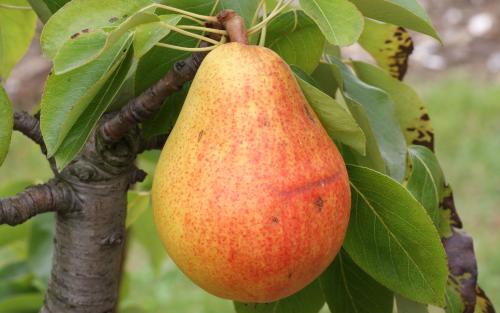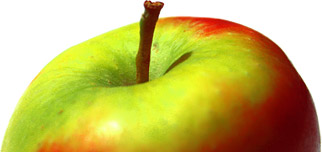
An attractive and well-known 19th century American pear. It ripens early season, and does not keep.
Clapp Favorite pear identification images
All images copyright Orange Pippin unless otherwise stated.
USDA identification images for Clapp Favorite
The identification paintings in the USDA Pomological Watercolor Collection span the years 1886 to 1942.
Citation: U.S. Department of Agriculture Pomological Watercolor Collection. Rare and Special Collections, National Agricultural Library, Beltsville, MD 20705.
Sports of this variety
Sports are natural genetic mutations of the original variety.
Visitor reviews
- 06 Jan 2020 CAMBS, United KingdomMy family inherited this pear tree when we moved to a small holding near Wisbech in the UK. This year I had the tree DNA and found it is a Clapps Favourite a variety I had not heard of. It was planted about 1910 in an orchard containing conference, william and comice pears. Amazing how it got here! It suffers badly from black spot, has split and needs strapping otherwise crops profusely every year. Big tree.
- 27 Aug 2018 MO, United StatesMy parents had a tree and they were wonderful tasting pears, but as stated they needed to be picked early or they would rot from the inside. The tree was in Manchester, MI. I currently live in Nixa, MO. Thank you for your site, as I’ve been having difficulty remembering the name. Doris
- 22 Nov 2017 MASSACHUSETTS, United StatesThis is a wonderful pear, but for just a few days each season. It is a large, good looking, yellow pear, with an orange blush when ripe. It will ripen very well on the tree, and unlike many pears, does not improve with storage. Flavor and mouth feel are a delight when it is properly ripe, but a perfect pear turns to a bad tasting mushy pear in just a few days. It is best with 2 pickings, and is good for home garden use. If sold at a stand, it should be to educated customers. People who know about it ask for it, because it can't be found in stores, and it can be a reason that folks come to your stand. I have not had a fireblight problem, but have heard that it can be a problem.
Tree register
United States
- George Paquin in CHELMSFORD, MA
- Glen in COUPEVILLE, WA
- Larry Landis in Corvallis, OREGON
Netherlands
- Cheuk A Lam in Amsterdam, NOORD-HOLLAND
Origins
- Species: Pyrus communis - Pear
- Originates from: Dorchester, MA, United States
- Introduced: 1860
- Developed by: Thaddeus Clapp
- UK National Fruit Collection accession: 1975-319
Identification
- Country of origin: United States
- Period of origin: 1850 - 1899
- Fruit colour: Yellow / Orange
- Flower colour: White
- Leaf colour: Green
- Annual cycle: Deciduous
- Fruit size: Average
Using
- Picking season: Early
- Keeping (of fruit): 1-3 days
- Flavour quality: Very good
- Flavour quality: Good
- Cropping: Good
- Fruit persistence: Normal ripening
- Food uses: Eating fresh
- Food uses: Culinary
- Picking period: mid-August
- Wildlife: RHS Plants for Pollinators
Growing
- Gardening skill: Average
- Flowering group: 4
- Pollinating others: Average
- Ploidy: Diploid
- Vigour: Slightly large
- Bearing regularity: Regular
- Attractive features: Attractive fruit
- Self-fertility: Not self-fertile
Climate
- Cold hardiness (USDA): Zone 3 (-40C)
- Climate suitability: Temperate climates
- Climate suitability: Warm climates
- Summer average maximum temperatures: Warm (25-30C / 76-85F)
Other qualities
- Disease resistance: Poor
- Scab (Apple and Pear): Very susceptible
- Fire blight: Very susceptible
Where to buy trees
The following tree nurseries offer Clapp Favorite pear trees for sale:
- Orange Pippin Fruit Trees (UK) United Kingdom
Clapps Favourite pear trees - Thomas Fruit Trees (EU) France
Clapp's Favorite pear trees
Where to buy fresh fruit
No orchards have registered as growing this variety. If you grow this and want to register please go to our Orchard Registration form.
References
- The Book of Pears (2015)
Author: Morgan
210 - The Fruit Manual
Author: Hogg

